Blue space
Blue space (also referred to as blue infrastructure) in urban planning and design comprises all the areas dominated by surface waterbodies or watercourses. In conjunction with greenspace (parks, gardens, etc. specifically: urban open space), it may help in reducing the risks of heat-related illness from high urban temperatures (urban heat island).[1] Substantial urban waterbodies naturally exist as integral features of the geography of many cities because of their historical geopolitical significance, i.e. the River Thames in London.[2]
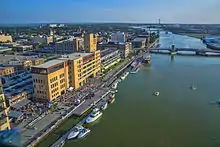
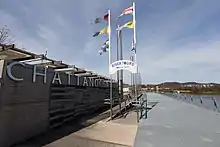
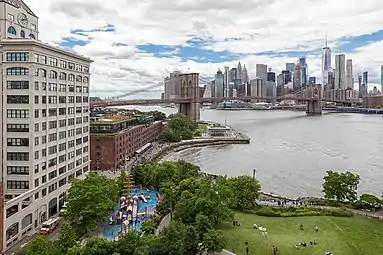
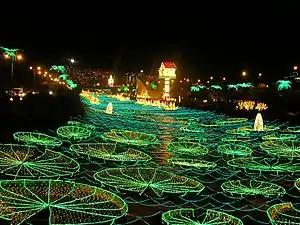
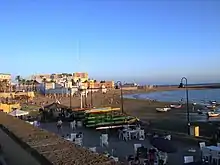
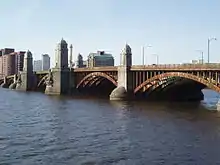
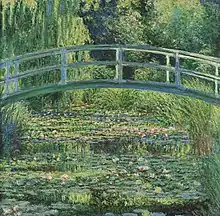
Accessible blue spaces can help revitalizing neighborhoods and promote increased social connectedness[3] as seen on waterfront renovation projects like the Chattanoga Waterfront, Chattanoga, TS,USA, the CityDeck in Green Bay, WI, USA, or the Brooklyn Bridge Park in New York, NY, USA, [4] further enhanced by waterfront festivals such as the Christmas lights in Medellin, in Colombia. Design guidelines promoting healthy buildings -such as, WELL -managed by The International WELL Building Institute™ (IWBI™),[5] or Fitwel -developed and managed by The Center for Active Design (CfAD),[6] recommend incorporating including and water features as a strategy to improve the health and wellness of the building occupants, and "the 9 foundations of a Healthy Building" -developed at Harvard T.H. Chan School of Public Health-,[7] also recommends indoor access to nature views or nature-inspired elements.
Because neighborhoods with access to attractive natural features are susceptible of gentrification,[8] the social benefits associated with waterbodies can be unequally distributed, with Environmental Justice areas lacking access to good quality blue spaces.[9]
Health benefits of blue spaces
Proximity to water bodies may bring some risks to humans, like water-borne diseases in drinking water, [10]flooding risks, [11]or drowning.[12] But scientific evidence shows that exposure to blue spaces is also associated with a variety of health benefits to those near water bodies.[13][14] One of the mechanisms by which this phenomenon can be explained is by the Biophilia hypothesis developed by Edward O. Wilson. This theory states that humans have developed a strong connection with nature throughout their evolution that leads to subconscious seeking for natural environments, including green and blue spaces. Recent research has identified three main pathways that can further explain why proximity to green and blue spaces can be beneficial to health. One of them -Mitigation- adresses these health benefits in relationship to the physical improvements that natural environments bring to the built environment, such as reduction of urban heat island, traffic air pollution or traffic noise. A second one -Instoration- focuses on the promotion of physical activity and other positive outcomes associated with increased physical activity and social connectivity promoted by natural spaces. The last one -Restoration-explains how the non-threatening characteristics of the natural environments may reduce negative feelings and increase cognitive restoration.[15]
Effects of blue spaces on physical health
Increased physical activity
A variety of studies have found that people living near coastal areas, are less sedentary more likely to engage in moderate and vigorous physical activity adequate for health,[16] which could be explained due to the encouraging presence of walk paths along the coast. Another possible explanation is found in the aesthetical attributes of blue spaces that may motivate individuals to engage in physical activities on blue spaces.[17]But proximity to water bodies alone is not enough to promote increased levels of physical activity, as those bodies need to be accessible to people. A study focusing on teenagers found that those living near beaches that had a major road between their homes and the water body had lower levels of physical activity than those with a direct access to the beach.[18]
Reduced obesity
Blue spaces may reduce obesity as it promotes increased physical activity, and a study suggest that living far from green or waterfront in urban areas may increase the risk of obesity.[19]
Improved respiratory health
Living near blue spaces can improve the quality of life of people with respiratory diseases, such as asthma, which could be explained by the mists and sprays generated by the water movement [20]as shown on a study measuring the impact in health of green and blue spaces for those with chronic obstructive pulmonary disease (COPD).[21]
Effects of blue spaces on mental health
Improved overall mental health
Researchers found a reduction of psychiatric cases on people living near green or coastal areas.[22] Some of the studies found that ocean exposure or running along river helped war veterans suffering from PTSD.[23] Others found that engaging in water-related activities such as surfing can help coping with mental health issues and help developing self-confidence and self-reliance skills.[24]
Improved mood and happiness
Exposure to blue spaces is also linked to increased happiness. A group of researchers studying the effect of green and blue spaces on happiness used a mobile app to track mood feelings of people when they were near water landscapes. The researchers found increased levels of happiness in people near water bodies. [25] Consistently with the findings focusing on physical health, the positive effects on mood associated to blue spaces seem to diminish as the distance between the residence and the water increases. [26]
Improved recovery from drug and alcohol addiction
Educational interventions in blue spaces -such as sailing - have been shown to have positive perceived effects on people undergoing drug and alcohol rehabilitation.[27]
Blue spaces health effects assessment methods
Assessing the environmental benefits of a blue space intervention can be done by conducting a Health impact assessment (HIA). Additionally, a group of researches has developed a novel tool specifically designed to quantify the health benefits of blue spaces.[28]
See also
References
- Gunawardena, K.R.; Wells, M.J.; Kershaw, T. (15 April 2017). "Utilising green and bluespace to mitigate urban heat island intensity". Science of the Total Environment. 584–585: 1040–1055. Bibcode:2017ScTEn.584.1040G. doi:10.1016/j.scitotenv.2017.01.158. ISSN 0048-9697. PMID 28161043.
- Gunawardena, K.R.; Wells, M.J.; Kershaw, T. (2017). "Utilising green and bluespace to mitigate urban heat island intensity". Science of the Total Environment. Elsevier BV. 584–585: 1040–1055. Bibcode:2017ScTEn.584.1040G. doi:10.1016/j.scitotenv.2017.01.158. ISSN 0048-9697. PMID 28161043.CS1 maint: ref=harv (link)
- White, Mathew P.; Elliott, Lewis R.; Gascon, Mireia; Roberts, Bethany; Fleming, Lora E. (1 December 2020). "Blue space, health and well-being: A narrative overview and synthesis of potential benefits". Environmental Research. 191: 110169. Bibcode:2020ER....191k0169W. doi:10.1016/j.envres.2020.110169. ISSN 0013-9351. PMID 32971082.
- Gamble, David (2016). Rebuilding the American city : design and strategy for the 21st century core. New York, NY. ISBN 9781138798144.
- "International WELL Building Institute". www.wellcertified.com.
- "Fitwel". www.fitwel.org. Retrieved 1 December 2020.
- "9 Foundations of a Healthy Building". 9 Foundations. Retrieved 2020-12-29.
- Ngom, Roland; Gosselin, Pierre; Blais, Claudia (1 January 2016). "Reduction of disparities in access to green spaces: Their geographic insertion and recreational functions matter". Applied Geography. 66: 35–51. doi:10.1016/j.apgeog.2015.11.008. ISSN 0143-6228.
- Schüle, Steffen Andreas; Hilz, Lisa Karla; Dreger, Stefanie; Bolte, Gabriele (4 April 2019). [doi: 10.3390/ijerph16071216 "Social Inequalities in Environmental Resources of Green and Blue Spaces: A Review of Evidence in the WHO European Region"] Check
|url=value (help). International Journal of Environmental Research and Public Health. 16 (7): 1216. doi:10.3390/ijerph16071216. ISSN 1660-4601. PMC 6480666. PMID 30987381. - https://www.who.int/water_sanitation_health/diseases-risks/diseases/diseasefact/en/
- Kaźmierczak, Aleksandra; Cavan, Gina (2011). "Surface water flooding risk to urban communities: Analysis of vulnerability, hazard and exposure". Landscape and Urban Planning. 103 (2): 185-197. doi:10.1016/j.landurbplan.2011.07.008.
- https://www.cdc.gov/homeandrecreationalsafety/water-safety/waterinjuries-factsheet.html#:~:text=Who%20is%20most%20at%20risk,die%20from%20drowning%20are%20male.&text=Children%3A%20Children%20ages%201%20to,one%2Dthird%20died%20from%20drowning.
- Britton, Easkey; Kindermann, Gesche; Domegan, Christine; Carlin, Caitriona (18 December 2018). "Blue care: a systematic review of blue space interventions for health and wellbeing". Health Promotion International. 35 (1): 50–69. doi:10.1093/heapro/day103. ISSN 0957-4824. PMC 7245048. PMID 30561661.
- Gascon, Mireia; Zijlema, Wilma; Vert, Cristina; White, Mathew P.; Nieuwenhuijsen, Mark J. (1 November 2017). "Outdoor blue spaces, human health and well-being: A systematic review of quantitative studies". International Journal of Hygiene and Environmental Health. 220 (8): 1207–1221. doi:10.1016/j.ijheh.2017.08.004. hdl:10230/33228. ISSN 1438-4639. PMID 28843736.
- Markevych, Iana; Schoierer, Julia; Hartig, Terry; Chudnovsky, Alexandra; Hystad, Perry; Dzhambov, Angel M.; de Vries, Sjerp; Triguero-Mas, Margarita; Brauer, Michael; Nieuwenhuijsen, Mark J.; Lupp, Gerd; Richardson, Elizabeth A.; Astell-Burt, Thomas; Dimitrova, Donka; Feng, Xiaoqi; Sadeh, Maya; Standl, Marie; Heinrich, Joachim; Fuertes, Elaine (1 October 2017). "Exploring pathways linking greenspace to health: Theoretical and methodological guidance". Environmental Research. 158: 301–317. Bibcode:2017ER....158..301M. doi:10.1016/j.envres.2017.06.028. hdl:10044/1/58798. ISSN 0013-9351. PMID 28672128. S2CID 1231444.
- Bauman, Adrian; Smith, Ben; Stoker, Lyn; Bellew, Bill; Booth, Michael (1999). "Geographical influences upon physical activity participation: evidence of a 'coastal effect'". Australian and New Zealand Journal of Public Health. 23 (3): 322–324. doi:10.1111/j.1467-842X.1999.tb01265.x. ISSN 1753-6405. PMID 10388181. S2CID 697709.
- Humpel, Nancy; Owen, Neville; Iverson, Don; Leslie, Eva; Bauman, Adrian (February 2004). "Perceived environment attributes, residential location, and walking for particular purposes". American Journal of Preventive Medicine. 26 (2): 119–125. doi:10.1016/j.amepre.2003.10.005. ISSN 0749-3797. PMID 14751322.
- Edwards, Nicole Joy; Giles-Corti, Billie; Larson, Ann; Beesley, Bridget (1 July 2014). "The Effect of Proximity on Park and Beach Use and Physical Activity Among Rural Adolescents". Journal of Physical Activity and Health. 11 (5): 977–984. doi:10.1123/jpah.2011-0332. ISSN 1543-5474. PMID 23493147.
- Halonen, Jaana I.; Kivimäki, Mika; Pentti, Jaana; Stenholm, Sari; Kawachi, Ichiro; Subramanian, S. V.; Vahtera, Jussi (2014). "Green and blue areas as predictors of overweight and obesity in an 8-year follow-up study". Obesity. 22 (8): 1910–1917. doi:10.1002/oby.20772. ISSN 1930-739X. PMID 24771608. S2CID 21318788.
- Gaisberger, Martin; Šanović, Renata; Dobias, Heidemarie; Kolarž, Predrag; Moder, Angelika; Thalhamer, Josef; Selimović, Amina; Huttegger, Isidor; Ritter, Markus; Hartl, Arnulf (1 October 2012). "Effects of Ionized Waterfall Aerosol on Pediatric Allergic Asthma". Journal of Asthma. 49 (8): 830–838. doi:10.3109/02770903.2012.705408. ISSN 0277-0903. PMID 22861198. S2CID 18607451.
- Moitra, Subhabrata; Benet, Marta; Arbillaga-Etxarri, Ane; Marín, Alicia; Barberan-Garcia, Anael; Borrell, Eulàlia; Rodríguez, Diego; Gimeno-Santos, Elena; Balcells, Eva; Koreny, Maria; Monteagudo, Mónica; Torán-Montserrat, Pere; Vall-Casas, Pere; Rodríguez-Roisin, Robert; Garcia-Aymerich, Judith (15 September 2018). "Association between interpersonal and environmental factors and health-related quality of life in patients with chronic obstructive pulmonary disease (COPD)". European Respiratory Journal. 52 (suppl 62): PA1179. doi:10.1183/13993003.congress-2018.PA1179. ISSN 0903-1936.
- Alcock, I.; White, M. P.; Lovell, R.; Higgins, S. L.; Osborne, N. J.; Husk, K.; Wheeler, B. W. (1 October 2015). "What accounts for 'England's green and pleasant land'? A panel data analysis of mental health and land cover types in rural England". Landscape and Urban Planning. 142: 38–46. doi:10.1016/j.landurbplan.2015.05.008. hdl:10871/17512. ISSN 0169-2046.
- Dustin, Daniel, et al. "The Promise of River Running as a Therapeutic Medium for Veterans Coping with Post-Traumatic Stress Disorder." Therapeutic recreation journal 45.4 (2011): 326-40. ProQuest. Web. 10 Nov. 2020.
- Godfrey, C. "The Positive Impact of Structured Surfing Courses on the Wellbeing of Vulnerable Young People." Community Practitioner. 88.1 (2015): 26. Web.
- MacKerron, George; Mourato, Susana (1 October 2013). "Happiness is greater in natural environments". Global Environmental Change. 23 (5): 992–1000. doi:10.1016/j.gloenvcha.2013.03.010. ISSN 0959-3780.
- Brereton, Finbarr; Clinch, J. Peter; Ferreira, Susana (1 April 2008). "Happiness, geography and the environment". Ecological Economics. 65 (2): 386–396. doi:10.1016/j.ecolecon.2007.07.008. ISSN 0921-8009.
- Robert White, Charles Abraham, Jane R. Smith, Mathew White & Petra K. Staiger (2016) Recovery under sail: Rehabilitation clients' experience of a sail training voyage, Addiction Research & Theory, 24:5, 355-365, DOI: 10.3109/16066359.2015.1123252
- Himansu Sekhar Mishra,Simon Bell, Peeter Vassiljev, Friedrich Kuhlmann, Gloria Niin, James Grellier (1 March 2020). "The development of a tool for assessing the environmental qualities of urban blue spaces". Urban Forestry & Urban Greening. 49: 126575. doi:10.1016/j.ufug.2019.126575. ISSN 1618-8667.CS1 maint: multiple names: authors list (link)